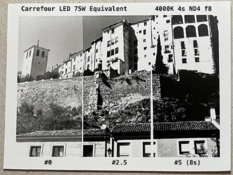I've started to experiment replacing the PH211 Opal with OTS LED E27's, and I will post results on this same thread including actual pictures developed with each one and other details.
To start I grabbed some commercial Off The Shelf bulbs from Carrefour and fetched their technical specs from the ENERG Website. I will later grab other E27 one like 270 degree one with plastic bases from cheap dollar-store-style brands and compare results.
Light Sensitivity of ILFORD MG
This is the baseline sensitivity curve for ILFORD MG Papers:

Source: https://www.ilfordphoto.com/wp/wp-content/uploads/2021/01/MULTIGRADE-IV-RC-Papers-060619.pdf
Light Curves of Typical OTS E27 Light Bulbs
Here are the baseline Carrefour DY96xxx series bulbs which are full glass 360 deg E27
Carrefour 6500K
Carrefour DY96190 75W, 6500K, 1055 lm, 7.8 W, 80 CRI, Flicker 1, Strobe 0.4, EI=D
Carrefour DY96202 60W, 6500K, 806 lm, 5.9 W, 80 CRI, Flicker 1, Strobe 0.4, EI=D

Carrefour 4000K
Carrefour DY96192 75W, 4000K, 1055 lm, 7.8 W, 80 CRI, Flicker 1, Strobe 0.4, EI=D
Carrefour DY96204 60W, 4000K, 806 lm, 5.9 W, 80 CRI, Flicker 1, Strobe 0.4, EI=D

Carrefour 2700K
Carrefour DY96194 75W, 2700K, 1055 lm, 7.8W W, 80 CRI, Flicker 1, Strobe 0.4, EI=D
Carrefour DY96206 60W, 2700K, 806 lm, 5.9 W, 80 CRI, Flicker 1, Strobe 0.4, EI=D

Source: https://eprel.ec.europa.eu/screen/product/lightsources
Terms: lm = lumens, W = Watts, CRI = R9 Color Rendering Index, EI = ENERG Rating
Curve Overlaps
Here I tried to overlap the curves on somewhat the same scale to get a rough idea of the best matching bulbs.
Keep in mind that these curves may not be on the same Y scale but still gives a visual representation of the match.
Overlap with 6500K

Overlap with 4000K

Overlap with 2700K

Conclusions and Next Steps
It seems obvious that 4000K matches almost exactly with the sensitivity curves of ILFORD MG Papers so this will be the baseline to compare to. I will also include some experiments to compare with an incandescent opal bulb as well, all in different contrast ranges.
In the next few days/weeks I will do some actual development and document development times f stops, nd and contrast filters, to get a good idea of how well these cheap E27 LED bulbs compare to incandescent opals. I will be using a Durst M300.
To start I grabbed some commercial Off The Shelf bulbs from Carrefour and fetched their technical specs from the ENERG Website. I will later grab other E27 one like 270 degree one with plastic bases from cheap dollar-store-style brands and compare results.
Light Sensitivity of ILFORD MG
This is the baseline sensitivity curve for ILFORD MG Papers:
Source: https://www.ilfordphoto.com/wp/wp-content/uploads/2021/01/MULTIGRADE-IV-RC-Papers-060619.pdf
Light Curves of Typical OTS E27 Light Bulbs
Here are the baseline Carrefour DY96xxx series bulbs which are full glass 360 deg E27
Carrefour 6500K
Carrefour DY96190 75W, 6500K, 1055 lm, 7.8 W, 80 CRI, Flicker 1, Strobe 0.4, EI=D
Carrefour DY96202 60W, 6500K, 806 lm, 5.9 W, 80 CRI, Flicker 1, Strobe 0.4, EI=D
Carrefour 4000K
Carrefour DY96192 75W, 4000K, 1055 lm, 7.8 W, 80 CRI, Flicker 1, Strobe 0.4, EI=D
Carrefour DY96204 60W, 4000K, 806 lm, 5.9 W, 80 CRI, Flicker 1, Strobe 0.4, EI=D
Carrefour 2700K
Carrefour DY96194 75W, 2700K, 1055 lm, 7.8W W, 80 CRI, Flicker 1, Strobe 0.4, EI=D
Carrefour DY96206 60W, 2700K, 806 lm, 5.9 W, 80 CRI, Flicker 1, Strobe 0.4, EI=D
Source: https://eprel.ec.europa.eu/screen/product/lightsources
Terms: lm = lumens, W = Watts, CRI = R9 Color Rendering Index, EI = ENERG Rating
Curve Overlaps
Here I tried to overlap the curves on somewhat the same scale to get a rough idea of the best matching bulbs.
Keep in mind that these curves may not be on the same Y scale but still gives a visual representation of the match.
Overlap with 6500K
Overlap with 4000K
Overlap with 2700K
Conclusions and Next Steps
It seems obvious that 4000K matches almost exactly with the sensitivity curves of ILFORD MG Papers so this will be the baseline to compare to. I will also include some experiments to compare with an incandescent opal bulb as well, all in different contrast ranges.
In the next few days/weeks I will do some actual development and document development times f stops, nd and contrast filters, to get a good idea of how well these cheap E27 LED bulbs compare to incandescent opals. I will be using a Durst M300.
Last edited by a moderator:















